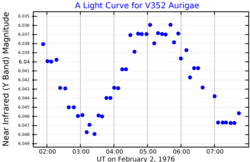
Delta Scuti, Latinized from δ Scuti, is a variable star in the southern constellation Scutum. With an apparent visual magnitude that fluctuates around 4.72, it is the fifth-brightest star in this small and otherwise undistinguished constellation. Analysis of the parallax measurements place this star at a distance of about 199 light-years from Earth. It is drifting closer with a radial velocity of −45 km/s.
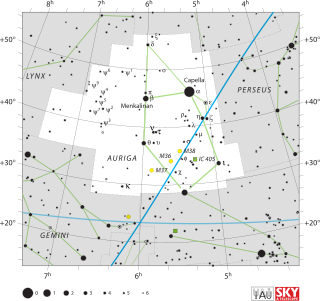
Chi Aurigae, Latinized from χ Aurigae, is the Bayer designation for a binary star system in the northern constellation of Auriga. It is visible to the naked eye with an apparent visual magnitude of 4.74. The distance of Chi Aurigae is determined at 3,900 ly based on spectroscopic observations. Parallax measurements by the Hipparcos spacecraft were unsuccessful because the parallax error was bigger than the value itself, while the Gaia spacecraft measured the parallax with a 22% error, giving a distance of 3590±750 ly. The brightness of the star is diminished by 1.26 in magnitude from extinction caused by intervening gas and dust.

28 Andromedae is a Delta Scuti variable star in the constellation Andromeda. 28 Andromedae is the Flamsteed designation. It also bears the variable star name GN Andromedae. Its apparent magnitude is 5.214, varying by less than 0.1 magnitudes.
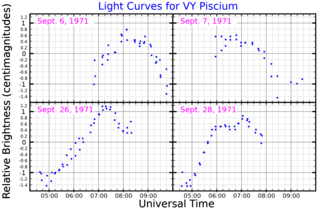
HR 515 is a variable star in the zodiac constellation of Pisces, near the eastern constellation border with Aries. Before the constellation borders were officially set, it held the Flamsteed designation of 3 Arietis, abbreviated 3 Ari). This star has the variable star designation VY Piscium, or VY Psc for short. It is a white-hued star that is near the lower limit of visibility to the naked eye with an apparent visual magnitude that ranges from 6.54 down to 6.59. Parallax measurements provide a distance estimate of approximately 503 light years from the Sun.

9 Aurigae is a star system in Auriga (constellation). It has an apparent magnitude of about 5, making it visible to the naked eye in many suburban skies. Parallax estimates made by the Hipparcos spacecraft put it at about 86 light-years from the solar system, although individual Gaia Data Release 3 parallaxes place all three components at 88 light years.
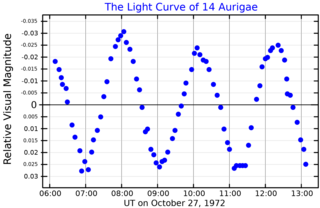
14 Aurigae is a quadruple star system located 269 light years away from the Sun in the zodiac constellation of Auriga. It has the variable star designation KW Aurigae, whereas 14 Aurigae is the Flamsteed designation. It is visible to the naked eye as a faint, white-hued star with a combined apparent visual magnitude of 5.01. The system is moving closer to the Sun with a heliocentric radial velocity of −9 km/s.

59 Aurigae, often abbreviated as 59 Aur, is a star in the constellation Auriga. Its baseline apparent magnitude is 6.1, meaning it can just barely be seen with the naked eye as a dim, yellow-white hued star. Based on parallax measurements, it is located about 483 light-years away from the Sun.
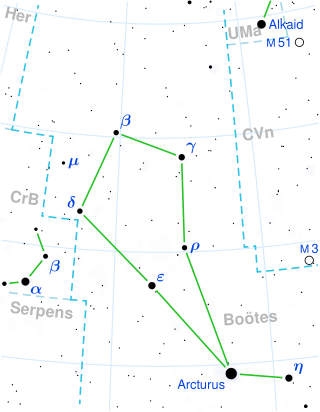
Iota Boötis is a member of a binary star system in the constellation Boötes, approximately 96 light-years from Earth. It has the traditional name Asellus Secundus and the Flamsteed designation 21 Boötis. The companion is HD 234121, a K0 main sequence star.

28 Cancri is a star system in the zodiac constellation of Cancer. It is a variable star with the designation CX Cancri, and is close to the lower limit of visibility with the naked eye, having a mean apparent visual magnitude of 6.05. The annual parallax shift seen from Earth's orbit is 8.5 mas, which provides a distance estimate of about 384 light years. It is moving away from the Sun with a radial velocity of around +9 km/s.

38 Cancri is a variable star in the zodiac constellation Cancer, located around 607 light years from the Sun. This object has the variable star designation BT Cancri; 38 Cancri is the Flamsteed designation. It is a member of the Praesepe cluster but is a challenge to view with the naked eye, having an apparent visual magnitude of 6.65. The star is moving closer to the Earth with a heliocentric radial velocity of +32 km/s.
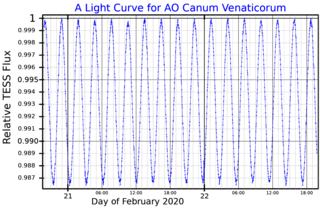
20 Canum Venaticorum is a single variable star in the northern constellation of Canes Venatici, located 238 light years from the Sun. This object has the variable star designation AO Canum Venaticorum; 20 Canum Venaticorum is the Flamsteed designation. It is visible to the naked eye as a faint, white-hued star with a baseline apparent visual magnitude of +4.72. The star is moving further from the Earth with a heliocentric radial velocity of +9 km/s. Eggen (1971) listed this star as a member of the Hyades Stream.

4 Canum Venaticorum is a binary star system in the northern constellation of Canes Venatici, located around 425 light years away. It has the variable star designation AI Canum Venaticorum; 4 Canum Venaticorum is its Flamsteed designation. Its brightness varies from magnitude +5.89 to +6.15 with a period of 2.8 hours, which places it around the lower limit of visibility to the naked eye. This was found to be a binary by Schmid et al. in 2014, based on periodic, non-sinusoidal changes in its radial velocity. It is a single-lined spectroscopic binary with an orbital period of 124.4 days and an eccentricity of 0.31.
KW Sagittarii is a red supergiant star, located approximately 2,420 parsecs away from the Sun in the direction of the constellation Sagittarius. It is one of the largest known stars, with a diameter about 1,000 times larger than the Sun. If placed at the center of the Solar System, the star's surface would engulf Mars, coming close to Jupiter's orbit.

NO Aurigae is a pulsating variable star in the constellation Auriga. It is an unusually-luminous asymptotic giant branch star about 3,500 light years away. It is a 6th magnitude star faintly visible to the naked eye under very good observing conditions.

21 Vulpeculae is a single, white-hued star in the northern constellation of Vulpecula. Its distance can be estimated from the annual parallax shift of 10.4302±0.0696 mas, yielding a separation of 313 light years. The star is faintly visible to the naked eye at night, having an apparent visual magnitude of 5.19. It is moving further away with a heliocentric radial velocity of about +7 km/s, having come within 243 ly (74.53 pc) around 4.2 million years ago.

UY Scuti (BD-12°5055) is a red supergiant star, located 5,900 light-years away in the constellation Scutum. It is also a pulsating variable star, with a maximum brightness of magnitude 8.29 and a minimum of magnitude 10.56, which is too dim for naked-eye visibility. It is considered to be one of the largest known stars, with a radius estimated at 909 solar radii, thus a volume of 750 million times that of the Sun. This estimate implies if it were placed at the center of the Solar System, its photosphere would extend past the orbit of Mars or even the asteroid belt.

BF Antliae, or HD 86301, is a variable star in the southern constellation of Antlia. It has a baseline apparent visual magnitude of 6.32, which indicates it lies near the lower limit of naked eye visibility for faint stars. The distance to BF Ant, as determined from its annual parallax shift of 6.9 mas, is 473 light years. It is moving further away with a heliocentric radial velocity of +18 km/s.

Rho Phoenicis is a variable star in the constellation of Phoenix. From parallax measurements by the Gaia spacecraft, it is located at a distance of 245 light-years from Earth.

FG Virginis is a well-studied variable star in the equatorial constellation of Virgo. It is a dim star, near the lower limit of visibility to the naked eye, with an apparent visual magnitude that ranges from 6.53 down to 6.58. The star is located at a distance of 273.5 light years from the Sun based on parallax measurements, and is drifting further away with a radial velocity of +16 km/s. Because of its position near the ecliptic, it is subject to lunar occultations.

HR 1170, also known as HD 23728 and V376 Persei, is a star about 220 light years from the Earth, in the constellation Perseus. It is a 5th magnitude star, so it will be faintly visible to the naked eye of an observer far from city lights. It is a variable star, whose brightness varies slightly from magnitude 5.77 to 5.91.
